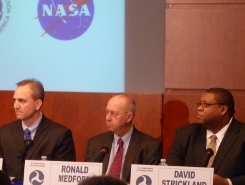NHTSA-NASA Study of Unintended Acceleration in Toyota Vehicles

The Department of Transportation released results from an unprecedented ten-month study of potential electronics-based causes for unintended acceleration in Toyota vehicles. NHTSA launched the study last spring at the request of Congress, and enlisted National Aeronautics and Space Administration (NASA) engineers with expertise in areas such as computer-controlled electronic systems, electromagnetic interference, and software integrity to conduct new research into whether electronics systems or electromagnetic interference played a role in alleged incidents of unintended acceleration. (Read the press release)
Note: Since public release of the NHTSA and NASA reports on February 8, 2011, the agency has revised its redactions to the reports to release certain material previously deemed confidential under 49 U.S.C. § 30167. The NHTSA and NASA reports currently on this web page, which were posted April 15, 2011, replace the ones posted previously and contain the revised redactions.
NHTSA Report on Toyota Unintended Acceleration Investigation
In March 2010, NHTSA enlisted the support of NASA in analyzing the Toyota electronic throttle control (ETC) system to determine whether it contained any vulnerabilities that might realistically be expected to produce unintended acceleration (UA) in a consumer’s use of those vehicles. NASA did not find an electronic cause of large throttle openings that can result in UA incidents. NHTSA did not find a vehicle-based cause of those incidents in addition to those causes already addressed by Toyota recalls.
This report presents NHTSA's studies and findings concerning UA in vehicles manufactured by Toyota. It should be read in conjunction with the report issued by NASA concerning the ETC system in Toyota vehicles.
NASA Report on Toyota Unintended Acceleration Investigation
NHTSA requested the NASA Engineering and Safety Center (NESC) to study unintended acceleration involving Toyota vehicles. The goal of the study was to determine if there are design and implementation vulnerabilities in the Toyota Electronic Throttle Control System Intelligent (ETCS-i) that could cause UAs and whether those vulnerabilities, if substantiated, could realistically occur in consumers' use of these vehicles.
- NASA Executive Summary
- NASA Full Report
> Appendix A: Software
> Appendix B: Fishbone Design
> Appendix C: Hardware
> Appendix D: Test Scenarios
Additional NHTSA Study Supporting Documentation
| EVENT DATA RECORDER (EDR) | GENERAL INFORMATION |
| > EDR Pre-Crash Validation (VRTC DCD9157-1WDC) | > Acronyms and Terms |
| > Toyota EDR Background (NHTSA-NVS-2011-ETC-SR04) | > Vehicle Characterization (VRTC-DCD9157-WDC) |
| > Reading Toyota EDR (NHTSA-NVS-2011-ETC-SR05) | > Search Keywords (NHTSA-NVS-2011-ETC-SR01) |
| > Toyota EDR Software Versions (NHTSA-NVS-2011-ETC-SR08) | > Peer Review (NHTSA-NVS-2011-ETC-SR14) |
| > Report of Fatal Crash (NHTSA-NVS-2011-ETC-SR09) | > Analysis of EMC Components (NHTSA-NVS-2011-ETC-SR15) |
| > Pre-Crash Field Inspections (NHTSA-NVS-2011-ETC-SR10) | |
| > Field Inspection Results Table (NHTSA-NVS-2011-ETC-SR11) | |
| > EDR Field Inspection Results Tables (NHTSA-NVS-2011-ETC-SR12) |




 RSS this page
RSS this page




